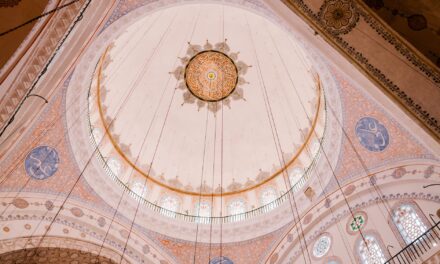There are two broad in the sciences of hadeeth.
‘Ilm ar-Riwaayah – linguistically: “knowledge of the narrations.”
‘Ilm ad-Diraayah – knowledge of the chains and conditions of hadith
‘Ilm ar-Riwaayah refers to the textual study of hadeeth. It is knowledge of what the hadeeth is saying along with the benefits and rules that can be extracted from it. ‘Ilm ad-Diraayah is the study of the chain of the hadeeth, and the principles that are used in determining the acceptability or unacceptability of a hadeeth.
To understand the relationship between Riwaayah and Diraayah, consider the context of fiqh. Fiqh is similar to ‘Ilm ar-Riwaayah just as Usool-al-Fiqh is similar to ‘Ilm ad-Diraayah. The practical aspect is the hadeeth itself and what we can learn from it, and this is known as ‘Ilm ar-Riwaayah. The complicated principles behind the scenes of the hadeeth which determines acceptance or rejection is ‘Ilm ad-Diraayah.
Sunnah
Sunnah is a term that has different meanings and different implication for each branch of Islamic science. Before explaining what a hadeeth is, one must understand what the Sunnah is according to the different disciplines of Islam. According to the Scholars of Al-Luga (Linguists), Sunnah is either:
A Way or Path, regardless of if it is good or bad Manner/Habit/Conduct As an example of this usage of “Sunnah”, is it is a Sunnah of mine that when I wake up, I brush my teeth every morning.
According to the Muhaditheen (Scholars of Hadith):
Sunnah is any statement, action, approval, physical attribute, manner, or conduct of Prophet Muhammad (ﷺ) both before and after revelation. Some Usoolis add to the definition: “and also the Sunnah of the Khulafah ar-Raashideen. (The 4 rightly guided Caliphs). This is done because the actions of the Khulafah can be used as legislation.
An example of the Muhaddith usage of Sunnah is:
- The Prophet (ﷺ) had curly hair and his hair went down to his shoulders. The Prophet (ﷺ) had broad shoulders.
It’s important to note that even something attributed to the Prophet ﷺ() before revelation can be used as Daleel (Proof) in Shariah. However, any of the above defined aspects of Sunnah attributed to the Prophet after revelation would abrogate and deem the former null and void.
According to the Usoolis (Scholars of the Principles in Shariah) Sunnah is any statement, action, or approval, of Prophet Muhammad (ﷺ) after revelation. Some Usoolis add to the definition: “and also the Sunnah of the Khulafah ar-Raashideen. (The 4 rightly guided Caliphs). This is done because the actions of the khulafah can be used as legislation, using the following hadeeth as Proof:
“Follow the My Sunnah, and the Sunnah of the 4 righteous khulafah after me.” Prophet Muhammad (ﷺ)
An example of the Usooli usage of Sunnah is: “Made permissible for us are two types of fish and two types of blood…..” [Bulugh al-Maram]. Notice that the Usooli definition of Sunnah is the same as the Muhaddith definition minus the physical attributes of the Prophet (ﷺ) and also subtracting anything that happened to Muhammad (ﷺ) before becoming a Prophet. This is because the scholars of Usool are only concerned with aspects that affect the general principles of Shari’ah. Physical attributes of the Prophet (ﷺ) before Prophethood does not have any weight in legislations found in the Shari’ah so this is left out. But the Muhaditheen are concerned with anything pertaining to the Prophet (ﷺ) so they include what the Usoolis have omitted.
According to the Fuqaha (Scholars of Jurisprudence) Sunnah is one of the 5 rulings of deeds that you get reward for if you do, but you do not get any punishment if you leave it.
The 5 rulings of deeds are:
- Fardh – Required
- Sunnah – Rewarded, but not mandatory
- Mubah – Permissible
- Makruh – Disliked
- Haraam – Forbidden
The Fuqaha also consider Sunnah to be the opposite of Fardh. This is because on a larger scale, the Fuqaha categorize all actions as something you must do, and something you do not have to do. If this schema is used, we find that Fardh is the only type of action that must be done while Sunnah, Mubah, Makruh, and Haraam are all on the other side of the scale as deeds that do not have to be done. If this categorization is used, then we understand why Sunnah is the opposite of fardh according to the Fuqaha. Example of a Sunnah ruling according to the Fuqaha : Praying 2 rakats before Dhuhr is Sunnah according to the majority of Fuqaha.
According to the Scholars of Aqeedah (Creed) : Sunnah is the opposite of bida’a (innovations in religion)
Hadith: “Whomsoever shows people a sunnah, whoever follows that path will have the same reward as the person that showed him without his reward decreasing in any way.
The Five definitions of Sunnah are summarized below:
- Linguistic – A path or way of conduct
- Hadith – Any statement, action, approval, physical attribute, manner, or conduct of Prophet Muhammad (ﷺ) both before and after revelation.
- Usool – Any statement, action, or approval, of Prophet Muhammad (ﷺ) after revelation.
- Fuqaha – One of the 5 rulings of deeds that you get reward for if you do, but you do not get any punishment if you leave it. The opposite of Fardh
- Aqeedah – The opposite of bida’a
Out of all the different usages of “Sunnah”, the Muhaddith definition is the most comprehensive. It includes the widest variety of aspects pertaining to the Prophet (ﷺ). It could also be said that these elements could be considered the five types of hadeeth. To better understand each element of the Sunnah, explanations and examples of ahadeeth of each type are defined below:
Statement: Something the Prophet (ﷺ) literally said. We find that the majority of ahadeeth that exist are actual statements of the Prophet () . Example: “Actions are only by intentions…” -Prophet Muhammad (ﷺ).
Action: a companion saw the Prophet sal Allahu alayhi wa sallam performing an action. We find that the second largest amount of ahadeeth preserved are actions performed by the Prophet (ﷺ). Example: Ibn ‘Umar: I got up on the house of Hafsa and I saw the Prophet salla Allahu alayhi wa sallam urinating, standing, facing Jerusalem.
Approvals: An action, or statement that took place during the time of the Prophet(ﷺ) and was known to the Prophet (ﷺ) in which there was no objection. Because the Prophet remained silent, this is considered a tacit form of acceptance of the action or statement of a sahabah. One might ask the question, what if a sahaba did something that the Prophet (ﷺ) didn’t see or was unaware of? To address this, we know that Allah sees everything, and if there was something that needed to be addressed, Allah would have revealed Qur’an to the Prophet (ﷺ). Example: Anas ibn Malik said, we used to practice cortus interruptus while the Qur’an was still be revealed. Example 2: Khalid ibn Waleed (r) : He was eating with the Prophet (ﷺ) with other companions in a far away place away from Medina and Makkah. The host brought some food. One of the things he brought was a Thub, a large type of lizard. Khalid was eating it and others were eating it but he noticed that the Prophet (ﷺ) was not eating it but he was not saying anything. Khalid asked the Prophet (ﷺ) is it haraam. The Prophet (ﷺ) said No, it just is not the food of my people.
*Note that in this Hadith of Khalid ibn Waleed (r) even if Khalid did not ask the Prophet (ﷺ) about the lizard, it still would have been halaal because the prophet (ﷺ).
Physical Attribute: A description of some particular characteristic of the Prophet () . Example: Hadith: The Prophet had curly hair and his hair went down to his shoulders. The Prophet (ﷺ) had broad shoulders.
Manner/Conduct: This aspect pertains to a mode of behavior or character trait of the Prophet (ﷺ). Example: Aisha said, “The Prophet (ﷺ) never complained about food. if he liked it, he would eat it, if he didn’t like it, he would leave it.”







Recent Comments